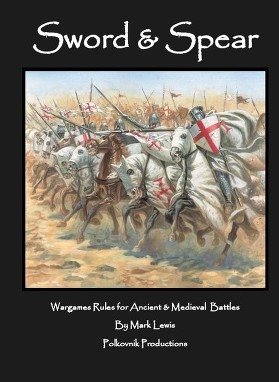
Sword & Spear
Sword & Spear is a set of wargames rules for large battles set in the Ancients & Medieval period. A typical game consists of about 12 units on each side and games take around 2 – 3 hours. The rules are designed from a top-down perspective, focusing on outcomes rather than detail.
The rules feature a clever and innovative system for activating units that creates interesting and challenging decisions, keeps both players involved at all times and has a lot of depth and subtlety. Each turn is split into phases, where players each receive a number of command dice, which are rolled and then used to activate their units. The number shown on each dice determines which units it can activate (with better quality units being easier to activate), what the unit can do when activated, and the numbers also determine the activation sequence. Certain dice also give bonuses to combat, movement distance or shooting range. So there is a lot to think about, and allocating the command dice well is the key to success (although rolling lots of sixes helps as well !).
In each phase command dice are allocated, then units are activated in order. When a unit is activated it does everything – movement, shooting and melee combat. So there is no turn sequence to remember and work through. A unit cannot be activated more than once in a turn, and typically most, but not all, units can be activated in a turn (although this depends on the quality of the units involved, so a horde of poor quality troops will not have so many units activated each turn.)
Each unit has a type (for example cavalry), a discipline rating (depending on the quality of the unit) and a strength rating. The strength depends on the unit type (for example cavalry are strength 3) and determines both the number of dice rolled in combat and the number of hits required to rout the unit. Many units will also have some specific weapons or characteristics such as Bows, Armoured, Spearmen or Impact, although an average level of protection and offensive ability is assumed, so for example, a unit of cavalry may simply be: Cavalry D4 S3.
– publisher's listing
- Designer
- Mark Lewis
- Publisher
- Polkovnik Productions
- Status
- In Print
- Basing
They are suitable for any scale figures and any basing standard. The only requirement is that figures are organised into units of equal frontage.
– publisher's listing
Back to RULES DIRECTORY
Areas of InterestAncients
Medieval
Featured Hobby News Article
Featured Link
Featured Ruleset
Featured Showcase Article Another week, another unit for the Amazon army!
Featured Workbench Article Adam loves Scorched Brown...
Featured Profile Article The Editor heads for Vicksburg...
|
Wargame Rules for Ancient & Medieval Battles
|










 (6.55)
(6.55)